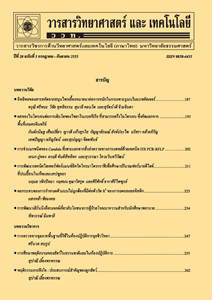ธรรมชาติของการอาศัยอยู่ในโพรงไม้และกล่องรังนกของนกเขตอบอุ่นในฤดูหนาว
Main Article Content
Abstract
In winter, some temperate zone birds roost in tree cavities or nest boxes. Some bird species use the same cavities as breeding sites and roosting sites throughout the year while the others select new cavities for roosting in non-breeding season. Roosting in the cavities gains more thermal benefits and energy savings than roosting in nest boxes. However, roosting in nest boxes decreases the risk from predators and ectoparasites.
Article Details
References
Jackson, J.A. and Jackson, B.J.S., 2004, Ecological relationships between fungi and woodpecker cavity sites, Condor 106: 37-49.
Amo, L., Tomas, G., Saavedra, I. and Visser, M.E., 2018, Wild great and blue tits do not avoid chemical cues of predators when selecting cavities for roosting, PLoS ONE 13(9): e0203269.
Mazgajski, T.D., 2002, Does the Great Spotted Woodpecker Dendrocopus major select holes for roosting?, Pol. J. Ecol. 50: 99-103.
Paclik, M. and Weidinger K., 2007, Microclimate of tree cavities during winter nights: Implications for roost site selection in birds, Int. J. Biomet. 51: 287-293.
Velky, M., Kanuch, P. and Kristin, P., 2010, Selection of roosting vegetation in the great tit, Parus major, during the winter period, Ethol. Ecol. Evol. 22: 305-310.
Gruebler, M.U., Widmer, S., Korner-Nievergelt, F. and Naef-Daenzer, B., 2014, Temperature characteristics of winter roost-sites for birds and mammals: Tree cavities and anthropogenic alternatives, Int. J. Biometeorol. 58: 629-637.
Mayer, L., Lustick, S. and Battersby, B., 1982, The importance of cavity roosting and hypothermia to the energy balance of the winter acclimatized Carolina chickadee, Int. Biometeor. 26: 231-238.
du Plessis, M.A. and Williams, J.B., 1994, Communal cavity roosting in Green Woodhoopoes: consequences for energy expenditure and the seasonal pattern of mortality, Auk 111: 292-299.
du Plessis, M.A., Weathers, W.W. and Koenig, W.D., 1994, Energetic benefits of communal roosting by Acorn Woodpeckers during the nonbreeding season, Condo. 96: 631-637.
Lambrechts, M.M., Adriaensen, F., Ardia, D.R., Artemyev, A.V., Atienzar, F., Banbura, J., Barba, E., Bouvier, J.-C., Camprodon, J., Cooper, C.B., Dawson, R.D., Eens, M., Eeva, T., Faivre, B., Garamszegi, L.Z., Goodenough, A.E., Gosler, A.G., Gregoire, A., Griffith, S.C., Gustafsson, L., Johnson, L.S., Kania, W., Keiss, O., Llambias, P.E., Mainwaring, M.C., Mand, R., Massa, B., Mazgajski, T.D., Moller, A.P., Moreno, J., Naef-Daenzer, B., Nilsson, J-A., Norte, A.C., Orell, M., Otter, K.A., Park, C.R., Perrins, C.M., Pinowski, J., Porkert, J., Potti, J., Rames, V., Richner, H., Rytkonen, S., Shiao, M.-T., Silverin, B., Slagsvold, T., Smith, H.G. Sorace, A., Stenning, M.J., Stewart, I., Thompson, C.F., Tryjanowski, P., Torok, J., van Noordwijk, A.J., Winkler, D.W. and Ziane, N., 2010, The design of artificial nestboxes for the study of secondary hole-nesting birds: A review of methodolo gical inconsistencies and potential biases, Acta Ornithol. 45: 1-26.
Winkel, W. and Hudde, H., 1988, Nest-box roosting of birds in winter, Vogelwarte 34: 147-188.
Kristin, A., Mihal, I. and Urban, P., 2001, Roosting of the great tit, Parus major and the nuthatch, Sitta europaea in nest boxes in an oak-hornbeam forest, Folia Zool. 50: 43-53.
Kempenaers, B. and Dhondt, A.A., 1991, Competition between Blue and Great Tit for roosting sites in winter: An aviary experiment, Ornis Scand. 22: 73-75.
Velky, M., 2006, Patterns in winter-roosting and breeding of birds in nest-boxes, Tichodroma 18: 89-96.
Drent, P.J., 1987, The importance of nestboxes for territory settlement, survival and density of the great tit, Ardea 75: 59-71.
Kluyver, H.N., 1957, Roosting habits, sexual dominance and survival in the great tit, Cold Spring Harb. Symp. Quant. Biol. 22: 281-285.
Kempenaers, B. and Dhondt, A.A., 1991, Competition between Blue and Great Tit for roosting sites in winter: An aviary experiment, Ornis Scand. 22: 73-75.
Dhondt, A.A., Blondel, J. and Perret, P., 2010, Why do Corsican Blue Tits Cyanistes caeruleus ogliastrae not use nest boxes for roosting?, J. Ornithol. 151: 95-101.
Ekner, A. and Tryjanowski, P., 2008, Do small hole nesting passerines detect cues left by a predator?: A test on winter roosting sites, Acta Ornithol. 43: 107-111.
Peterson, A.W. and Grubb, T.C.Jr., 1983, Artificial trees as a cavity substrate for woodpeckers, J. Wild. Manage. 47: 790-798.
Mainwaring, M.C. and Hartley, I.R., 2008, Covering nest boxes with wire mesh reduces greatspotted woodpecker Dendrocopos major predation of blue tit Cyanistes caeruleus nestlings, Lancashire, England, Cons. Evid. 5: 45-46.
Thomas, G., Merino, S., Moreno, J. and Morales, J., 2007, Consequences of nest reuse for parasite burden and female health and condition in blue tits, Cyanistes caeruleus, Anim. Behav. 73: 805-814.
Fargallo, J.A., Blanco, G., Potti, J. and Vinuela, J., 2001, Nestbox provisioning in a rural population of Eurasian Kestrels: Breeding performance, nest predation and parasitism, Bird Study 48: 236-244.


